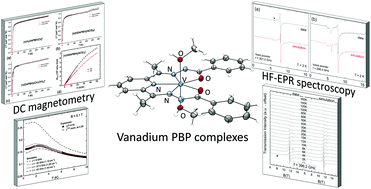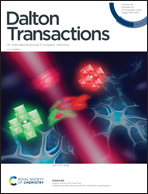The first pentagonal-bipyramidal vanadium(iii) complexes with a Schiff-base N3O2 pentadentate ligand: synthesis, structure and magnetic properties†
Abstract
A series of three mononuclear pentagonal-bipyramidal V(III) complexes with the equatorial pentadentate N3O2 ligand (2,6-diacethylpyridinebis(benzoylhydrazone), H2DAPBH) in the different charge states (H2DAPBH0, HDAPBH1−, DAPBH2−) and various apical ligands (Cl−, CH3OH, SCN−) were synthesized and characterized structurally and magnetically: [V(H2DAPBH)Cl2]Cl·C2H5OH (1), [V(HDAPBH)(NCS)2]·0.5CH3CN·0.5CH3OH (2) and [V(DAPBH)(CH3OH)2]Cl·CH3OH (3). All three complexes reveal paramagnetic behavior, resulting from isolated S = 1 spins with positive zero-field splitting energy expected for the high-spin ground state of the V3+ (3d2) ion in a PBP coordination. Detailed high-field EPR measurements for compound 3 show that its magnetic properties are best described by using the spin Hamiltonian with the positive ZFS energy (D = +4.1 cm−1) and pronounced dimer-like antiferromagnetic spin coupling (J = −1.1 cm−1). Theoretical analysis based on superexchange calculations reveals that the long-range spin coupling between distant V3+ ions (8.65 Å) is mediated through π-stacking contacts between the planar DAPBH2− ligands of two neighboring [V(DAPBH)(CH3OH)2]+ complexes.



 Please wait while we load your content...
Please wait while we load your content...